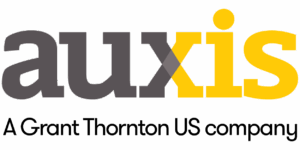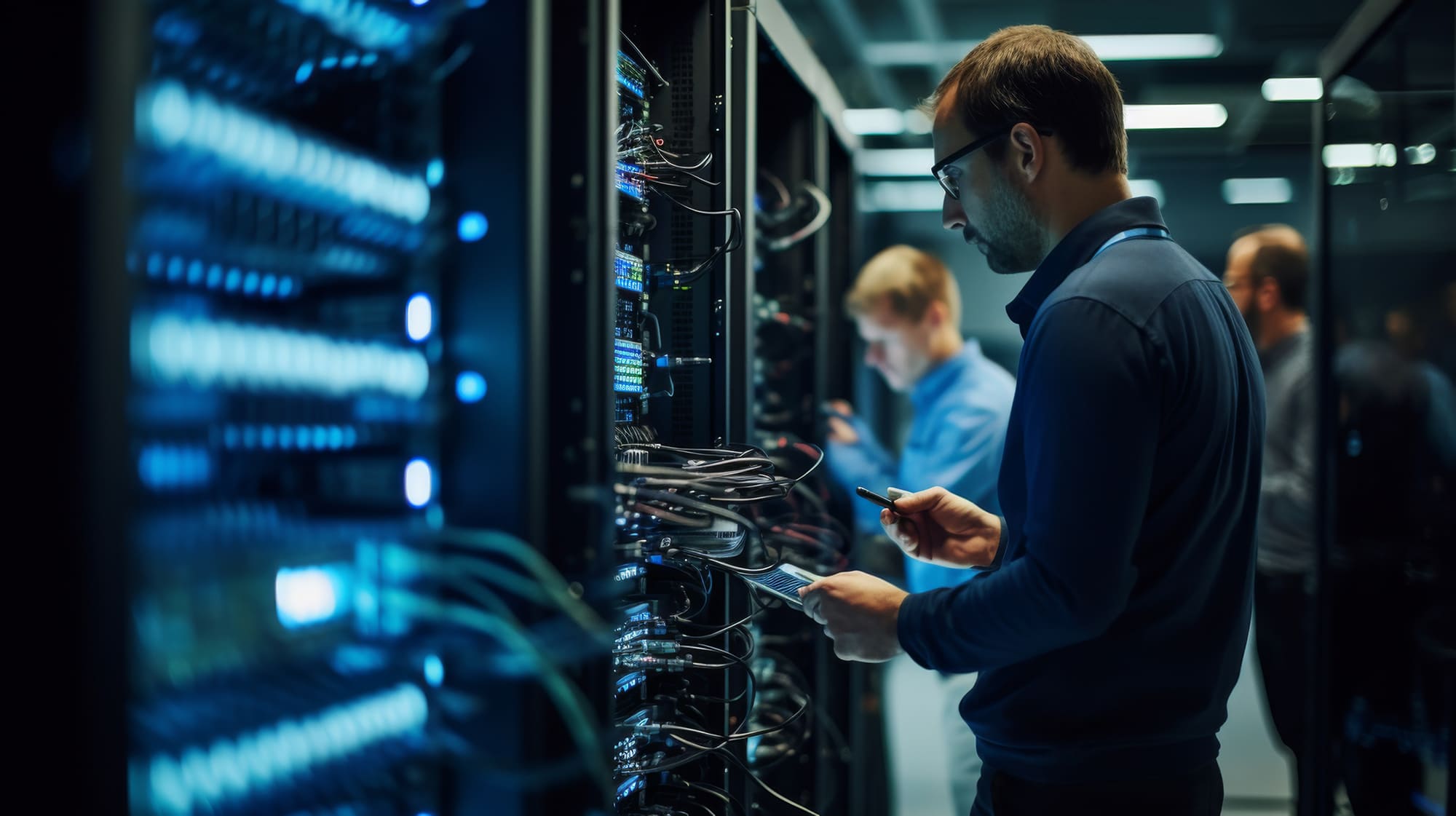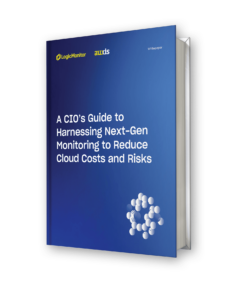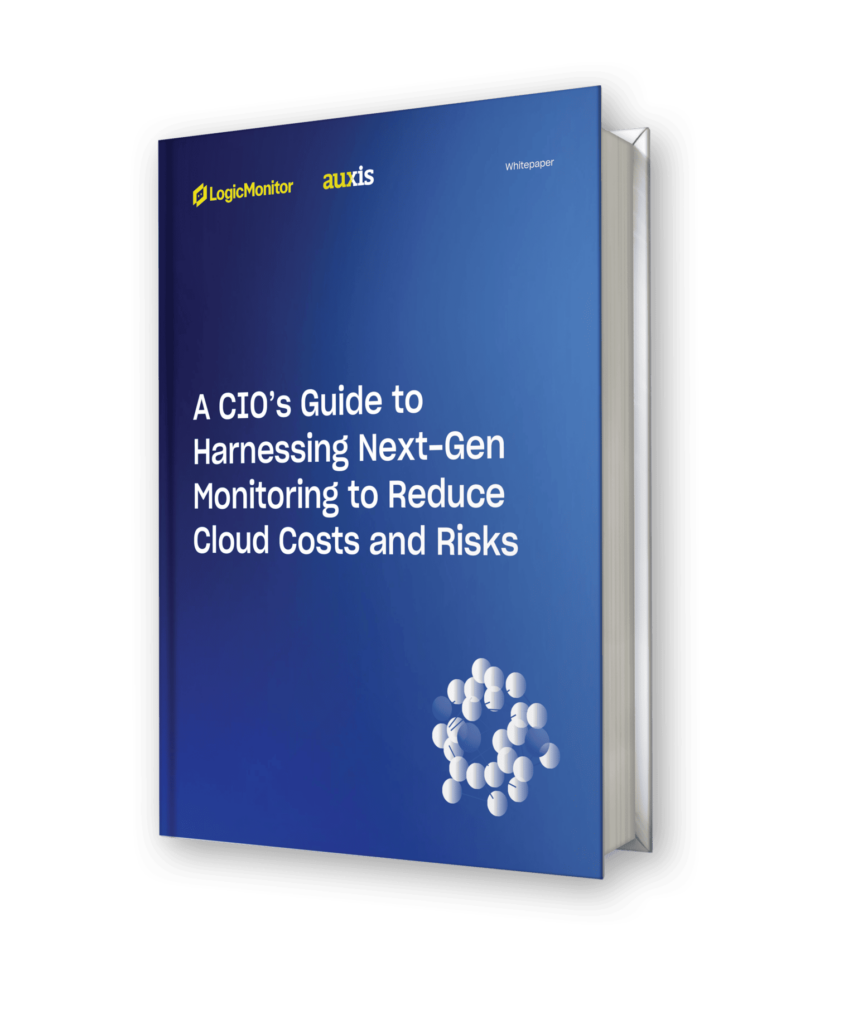In brief:
- Effective monitoring of IT infrastructure is crucial for ensuring system reliability, performance, and security.
- But the complexity of modern infrastructure and other challenges make infrastructure performance monitoring difficult for many IT organizations.
- Following best practices can ensure smooth business operations, from clear objectives that align with business goals to replacing tool sprawl with a unified, next-gen monitoring platform.
IT infrastructure forms the virtual backbone of every organization, supporting all operations and ensuring smooth execution of business processes. But its complexity is growing by leaps and bounds – as new technologies like cloud and AI emerge and organizations scramble to manage vast amounts of data, support new and complex services, ensure strong cybersecurity practices, support a growing number of digital services, and integrate various systems to ensure interoperability and prevent data silos.
In this environment, continuously observing networks, servers, applications, and other critical infrastructure components is essential for detecting anomalies, preventing downtime, and maintaining optimal and efficient operations. Yet, the complexity of IT infrastructure and the need to monitor on-premise, cloud, and hybrid systems make infrastructure monitoring no easy task today.
Most organizations struggle to maintain visibility across all layers of their infrastructure stack – managing multiple IT infrastructure monitoring tools across different environments amid escalating monitoring costs.
The yearly cost to businesses: $4 billion in time and resources spent troubleshooting and reacting to incidents that could be spent on innovation, a 2023 LogicMonitor report found.
This blog explores best practices for IT infrastructure monitoring, focusing on key strategies that enhance visibility, streamline operations, and improve overall system health.
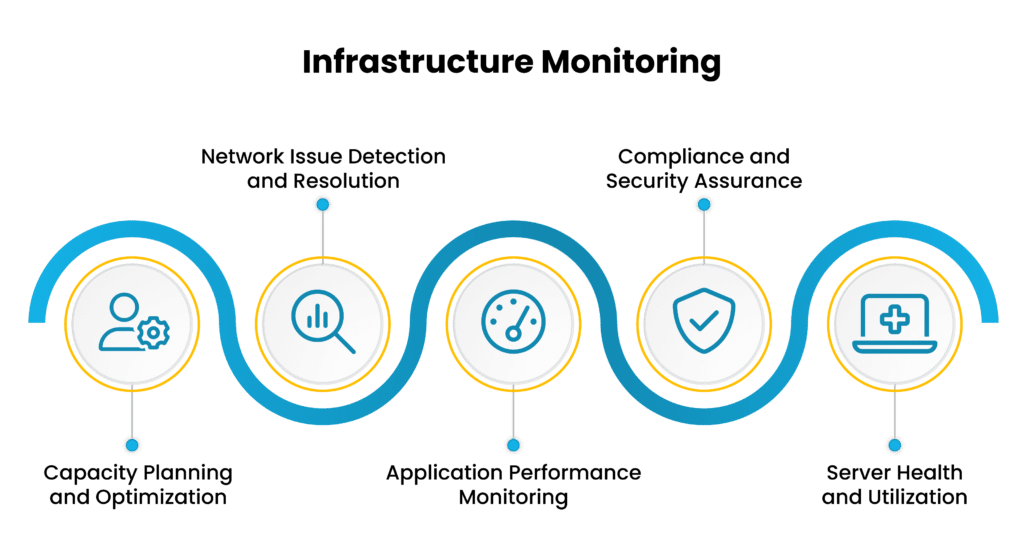
Ensure smooth business operations with IT infrastructure monitoring best practices
IT infrastructure monitoring encompasses various techniques and tools designed to track the performance and health of an organization’s IT environment. The primary objectives include:
- Performance Monitoring and Management: Ensuring that systems perform at their optimal levels.
- Fault Detection: Identifying and addressing issues before they impact users.
- Capacity Planning: Monitoring resource utilization to plan for future needs.
- Security Monitoring: Detecting and responding to security threats in real time.
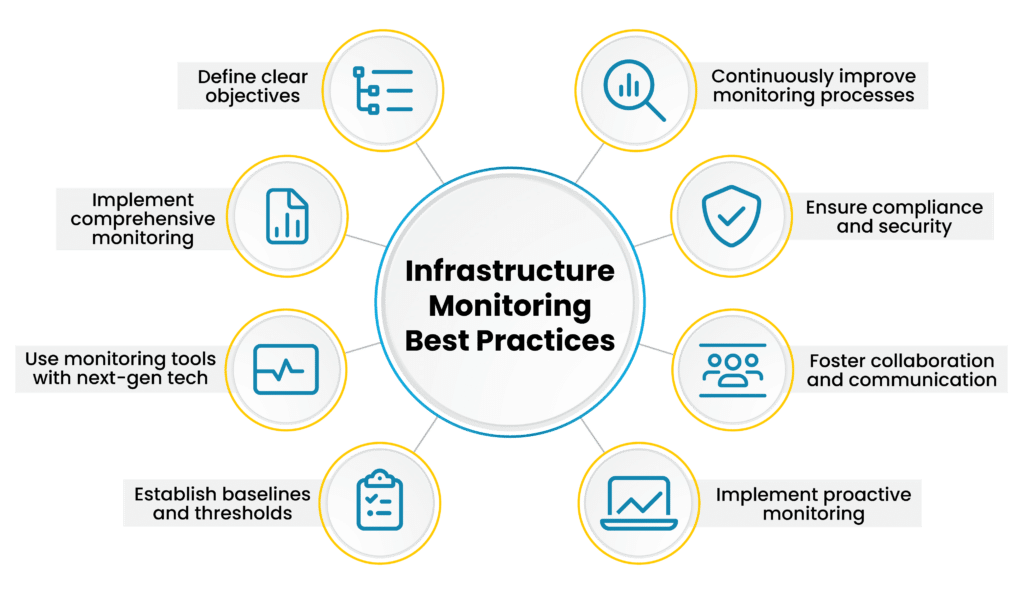
Adhering to simple IT infrastructure monitoring best practices helps organizations achieve these objectives and successfully gain visibility and insights across their infrastructure:
1. Define clear objectives
The first step in effective IT infrastructure monitoring is to establish clear objectives. These objectives should align with the organization’s business goals and IT strategy, ensuring that IT infrastructure directly contributes to broader business success.
Defining clear objectives also effectively guides the selection of infrastructure monitoring tools, the design of monitoring processes, and the establishment of measurable outcomes and benchmarks.
Common objectives include:
- Minimizing downtime and outages to align with the business goal of continuous service availability that enhances customer satisfaction and avoids revenue loss.
- Optimizing performance by identifying and resolving performance bottlenecks in real-time to provide a seamless user experience.
- Detect and respond to security threats and vulnerabilities to protect sensitive data and maintain customer trust.
2. Implement comprehensive monitoring
Comprehensive monitoring ensures that no aspect of the IT environment is overlooked, providing a holistic view of system health. It involves tracking all critical components of IT infrastructure, including:
- Networks: Monitor network traffic, utilization, latency, and connectivity issues.
- Servers: Track CPU usage, memory consumption, disk space, disk I/O, services, and server availability.
- Applications: Monitor application performance, response times, user experience, and error rates.
- Databases: Keep an eye on database performance, including Disk I/O, Cache Hit Ratio, Locking/Deadlocks, query execution times, transaction rates, and Replication Lag.
- Security: Implement security monitoring to detect vulnerabilities, intrusions, threats, and compliance breaches.
3. Take advantage of next-gen technology
As monitoring needs have grown and become more complex, monitoring tools have also proliferated. Today, nearly 40% of organizations juggle 11 to 30 monitoring tools to keep an eye on their application, infrastructure, and cloud environments – with 8% using between 21 and 30 tools (Sumo Logic “Tool Sprawl” report).
Such tool sprawl results in poor end-to-end visibility, delayed detection of outages, higher outage costs, and poor customer experiences.
Complex monitoring needs call for unified solutions that use next-gen technology like AI and automation to collect, correlate and put into context your end-to-end infrastructure data – also known as infrastructure observability. Such advanced monitoring platforms can detect patterns and anomalies that might be missed by traditional monitoring tools and manual processes.
Key features to look for in advanced monitoring tools include:
- Real-time alerts: Instant notification of critical alerts that could impact availability and performance.
- Dashboard visualization: Intuitive dashboards display key metrics and trends showing consolidated areas, expanding to provide detail, and allowing prediction of future capacity.
- Correlation: Minimize investigation on multiple alerts by correlating them into common issues for faster resolutions.
- Root cause analysis: Tools that help identify the underlying causes of issues by providing the right logs, associated alerts, and data that would expedite the investigation process.
- Automated remediation: Automated responses, or execution of actions, programs or scripts, to common problems, reducing the need for manual intervention.
4. Establish baselines and thresholds
Establishing baselines and thresholds is crucial for effective monitoring. Baselines represent normal performance levels of systems, such as average CPU usage over a typical week. Thresholds define acceptable limits, such as setting alerts for if CPU usage exceeds 80% for a sustained period.
Monitoring tools can compare real-time data against these baselines and thresholds, which might be normal for certain systems or applications, to detect deviations that may indicate issues. Regularly reviewing and updating these baselines and thresholds ensure they remain relevant as the IT environment evolves.
5. Implement proactive monitoring
Proactive monitoring involves continuously assessing IT systems to identify and address potential issues before they impact operations, ensuring optimal performance and minimizing downtime. This involves:
- Predictive analytics: Using historical data to predict future trends and potential problems.
- Capacity planning: Anticipating resource needs based on current usage patterns.
- Regular maintenance: Scheduling regular maintenance activities to prevent unexpected failures.
- Early warnings: Addressing issues, such as warning alerts, before they become critical alerts which will turn into outages, through early detection of these warnings that indicate future problems.
Today, most of the above can be achieved through next-gen, cloud-based monitoring and observability platforms. These integrated platforms continuously assess end-to-end IT systems and correlate infrastructure data for proactive detection of issues and troubleshooting. They also provide intelligent forecasting to future-proof the business with forward-thinking recommendations.
6. Foster collaboration and communication
Effective monitoring requires collaboration between different teams, including IT operations, security, and development. Establishing clear communication channels and protocols ensures that information about potential issues is shared promptly and addressed collaboratively.
Regular meetings and status reports are key to keeping everyone informed and aligned.
7. Ensure compliance and security
Monitoring tools should support compliance with relevant regulations and standards. This includes logging and auditing capabilities, secure data transmission, and regular security assessments.
Ensuring that monitoring practices comply with industry standards helps in avoiding legal issues and maintaining stakeholder trust. Monitoring logs, unauthorized access attempts, systems backups, and failover testing are some examples of key parameters that can help organizations achieve or keep regulatory compliance by demonstrating strong monitoring and controls practices.
8. Continuously improve monitoring processes
Continuous improvement is essential for keeping monitoring processes effective. Regularly reviewing and updating monitoring strategies, tools, their configurations, processes, and practices ensures they remain aligned with organizational goals and technological advancements.
Feedback from stakeholders and lessons learned from past incidents should inform these improvements.

Key challenges of implementing infrastructure monitoring tools in-house
Investing in infrastructure monitoring can deliver significant rewards: proactive issue detection, enhanced system performance and reliability, reduced downtime, cost optimization, and improved user satisfaction. Nearly 90% of organizations said they receive value from their monitoring investments, with 41% receiving over $1 million in total value per year (New Relic 2023 Observability Forecast report).
However, selecting and implementing the right infrastructure monitoring tool and strategies is often challenging for organizations, for the following reasons:
- Initial infrastructure monitoring software/hardware and costs: Setting up a comprehensive monitoring system requires purchasing and maintaining hardware, software or subscriptions for cloud services. This can be costly, especially for small and medium-sized enterprises. The total cost of monitoring can equate to up to 30% of total infrastructure spending!
- High cost of building an in-house maintenance team: Hiring skilled personnel to configure, manage, and operate the monitoring system adds to the cost. Training existing staff can also be expensive and time-consuming.
- Skill gaps: IT talent shortages over the last few years have made many internal IT teams short-staffed. Many lack the specialized skills and knowledge required to manage complex monitoring systems effectively.
- Complexity: Integrating various monitoring tools and ensuring they work seamlessly with existing infrastructure can be complex and requires the right skillset. Keeping up with emerging technologies also present a challenge for internal resources.
- Scalability: As the organization grows, the monitoring system must scale accordingly. This can involve significant reconfiguration and investment.
- Training: Continuous training and development are necessary to keep up with evolving technologies and IT infrastructure best practices.
- IT staff distracted from more important work: Implementation and on-going maintenance of monitoring systems demands significant time and effort from IT staff. Having multiple monitoring tools only adds to the effort required – creating data silos and “alert storms,” where different tools generate alerts for the same issue. These can easily overwhelm IT teams and make it difficult for them to identify and address critical issues effectively, detracting from their ability to focus on more strategic tasks.
An experienced IT infrastructure monitoring partner like Auxis brings tangible benefits for clients. Leveraging LogicMonitor, a unified and AI-driven observability platform rated as one of the best infrastructure monitoring tools, Auxis offers unprecedented visibility and intelligence into every part of your IT environment, without a big upfront technology investment.
Clients benefit from instant access to 24/7 monitoring, automated alerts, best-in-class processes, and proactive support. Auxis’ nearshore delivery model also solves IT labor shortages with top-notch engineers in your time zone, capable of managing your tech stack’s configurations and support at a significantly lower cost.
With a scalable, next-gen IT infrastructure monitoring solution tailored to your business’ unique needs and challenges, Auxis ensures implementation of monitoring best practices to drive high performance and availability of your IT systems and services.
Want to learn more about how IT infrastructure monitoring solutions can benefit your organization? Schedule a consultation with our IT infrastructure monitoring experts today! You can also visit our resource center for more IT outsourcing tips, strategies, and success stories.
